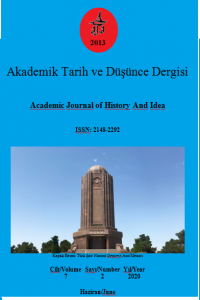Geçmişten Günümüze Münâfıkların Değişmeyen Karakteri (Kur’ân-ı Kerîm’deki Nitelikler)
Kelam ilminde, îmân konusu ele
alınırken, amelin îmândan bir cüz olup olmadığı ve büyük günah işleyen kimsenin
dünya ve ahiretteki konumu meselesinde gündeme gelen nifâk ya da münâfık
kavramı, îmân ve küfür konularından farklı olarak ele alınmışsa da fazla detaya
girilmemiştir. İman mefhumu dilin ikrarı, kalbin tasdîki veya marifet şeklinde
tanımlandığı gibi, îmânın fonksiyonel bir özelliğinin olması gerektiğinden
hareketle onun amel ile olan ilişkisi üzerinde durulmuştur. Îmân için yapılan
bu tanım, ortaya farklı görüşlerin çıkmasına sebep olmuştur. Tüm bu konular tartışılırken, nifâk ve
münâfık meselesinin detaylı bir şekilde işlenmemesi ise münâfıkların
kendilerine has belli bir ilmî ve itikadî disiplinlerinin olmadığı şeklinde
yorumlanması mümkündür. İtikâdî noktada münâfıkların ahiretteki durumlarının,
inkarcılarla birlikte olduğu kabul edilmiştir. Ancak bunların dünyaya bakan
yönlerinde bulunan niteliklerini belirleme yönünde Kur’ân âyetleri belirgin bir
rol oynamıştır.Kur’ân’ın bu grup hakkındaki nitelemesi ise onların itikadî bir
oluşum olmalarının aksine anarşik bir örgüt olduğu düşüncesini ön plana
çıkarmaktadır. Münafığın tanımı ile ilgili kelâmî eserlerde fazla ayrıntıya yer
verilmemiş, “iki yüzlü”, “zahiren mü’min gibi gözüken kâfir” gibi açıklamalarla
yetinilmiştir.
Kur’ân-ı Kerîm’in nifâk ve münâfıklarla
ilgili çok fazla ayrıntıya yer vermesi ise meselenin İslam toplumu açısından
önemli olduğu fikrini doğrulamaktadır.Kur’ân, teşhis edilmesi zor ve hatta
belli bir zamana kadar Müslüman muamelesine tabi tutulması gereken bu gizli
siyasi örgütün ve bağlılarının özelliklerini birçok âyette saymış, onlara karşı
alınması gereken tedbirleri de uzun uzun anlatmıştır. Evrensel olan Kur’ân’ın,
münâfıkların vasıflarını ortaya koyan bu geniş anlatımı, bunların her asır ve
coğrafyada İslam toplumunun başına bela olduğunun işaretlerini verdiği
düşünülebilir. Eşsiz belâğat ve fesâhatı ile mu’ciz olan Kur’ân, münafığın
sıfatları ile ilgili öylesine dehşet verici bir tablo çizmiştir ki gizli bir
kuruluş olmasına rağmen adeta o’nu milyonlarca kişinin içerisinden “işte münâfık
budur” denecek kadar bariz bir duruma getirmiştir. Bu çalışma ile, Kur’ân’ın bu
nitelemelerini daha çok günümüz dil terminolojisini kullanarak ele alma ve
İslam toplumunun ve bilim dünyasının istifadesine sunma amaçlanmıştır.
The Unchanging Character of the Sunumi Hypotheses from the Past (Qualities of the Qur'an)
When the subject
of belief is taken into consideration, the concept of disbelief or hypocrisy,
which is considered to be different from beliefs and beliefs, is not taken into
account, whether or not the deity is an immanent consort and who has committed
great sins in the world or in the hereafter. Relation with his deed is
emphasized in the sense that faith is a functional feature of belief, as
defined in the language of linguistics, the attitude of heart, or ingenuity.
This definition of faith has caused different opinions to emerge. When all
these issues are discussed, it is possible to interpret the hypocritical and
munificative issues in detail as if the hypocrites had no specific scientific
and ideological disciplines. It is accepted that in the present point the
hypocritical situation of the hypocrites is with the disbelievers. However, the
verses of the Qur'an played a significant role in determining their qualities
in the world-facing aspects. The qualification of the Qur'an about this group
gives rise to the idea that they are an anarchical organization, as opposed to
being an italic formation. The kalamî works related to the definition of the
mosque have not been given much detail, such as “two-faced”, “unbeliever who
looks like a lie”. The fact that the Qur'an contains much detail about the nifâk
and münâfıklar verifies that the matter is important in terms of Islamic
society. The Qur'an has counted many of these secret political associations and
their attributes that must be subjected to Muslim treatment until a certain
time, which is difficult to diagnose, and it has long described the precautions
to be taken against them. The universal Qur'an can be considered to have given
its signs that the qualities of the munafizi reveal that these are the troubles
of Islamic society in every century and geography. The Qur'an, with its unique
wisdom and suffering, has brought such a terrifying picture of the adjectives
of the sunnah, that although it is a secret organization, it has become so
obvious that it will be called "it is hypocritical" from within
millions of people. With this work, it was aimed to reconsider these qualities
of the Qur'an more by using the terminology of today's language and present it
to the Islamic society and the world of science.
Keywords:
Kalam, Belief, Faith, Discord, Hypocrites,
___
- ALPER, H., (2006). “Münâfık”, Türkiye Diyanet Vakfı Yayınları, C 31, İstanbul s. 565-568.
- ALPER, H., (2002). “Nifâk ya da İmanda Çatışma (Kur’ân-ı Kerîm Bağlamında Nifâk Psikolojisi)”, Marmara Üniversitesi İlâhiyat Fakültesi Dergisi, C 22, S 2002/1, İstanbul s. 5-24.
- ASBAHÂNÎ, N., (1988). Hilyetu’l-Evliya ve Tabakâti’l-Asfiya, Dâru’l-Kütübi’l-İlmiyye, Beyrut.
- ASKALÂNÎ, İ.H., (1960). Fethu’l-Bârî Bişerhi Sahîhi’l-Buhârî, Dâru’l-Ma’rife, Beyrut.
- ÂŞÛR, T., (1984). et-Tahrîr ve’t-Tenvîr, Dâru’t-Tûnûsiyye, Tunus.
- BÂBERTÎ, E., (2009). Şerhu Vasiyyeti’l-İmâm Ebî Hanîfe, Dâru’l-Feth.
- BUHÂRÎ, M. İ., (2002). Sahîhu’l-Buhârî, Haz. Muhammed Züheyr b. Nâsır, Dâru Tûki’n-Necât, Beyrut.
- ÇAĞRICI, M., (2008). “Riyâ”, Türkiye Diyanet Vakfı Yayınları, C 35, İstanbul s. 137-138.
- Yayın Aralığı: Yılda 6 Sayı
- Başlangıç: 2013
- Yayıncı: Hakan YILMAZ
Sayıdaki Diğer Makaleler
Yedinci Dönem TBMM’de Dokunulmazlık Tezkereleri (1943-1946)
Müslüman Türk Devletinin Tek Kadın Sultanı “Belkîs-i Cihan Raziye Begüm”
Kutup Şahi Hanedanlığı’nın Başkenti Golkonda’da Fars Dili Ve Edebiyatı
Arslan Argun İsyanına Farklı Bir Bakış
1970-ci İllərin Sovet Tarixşünaslığında Azərbaycan Xalq Cümhuriyyətinə Münasibət
I. Dareios’un İskit Seferinin Nedenleri Üzerine
Gelibolulu Mustafa ‘Âlî’nin Mirâtü’l Avâlim İsimli Eseri
Modern Dilbilim Terimlerinin Rusça Karşılıkları
Kamil Veli NERİMANOĞLU, İrina GÜNAY, Gencer GENÇOĞLU, Asude ÖZCAN
